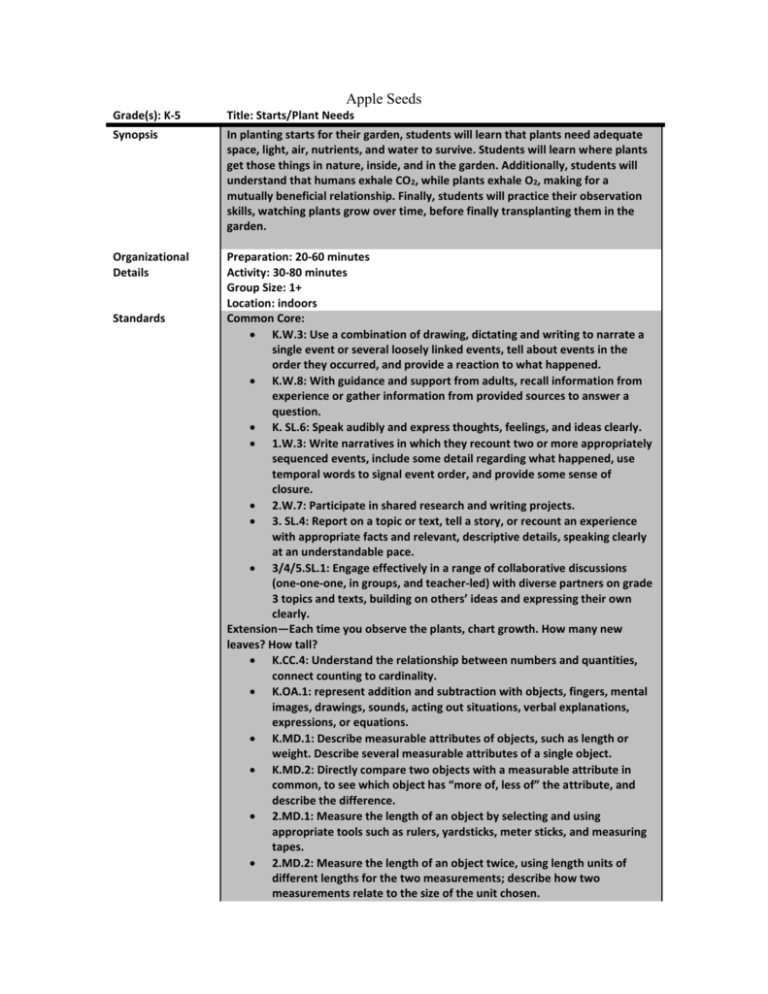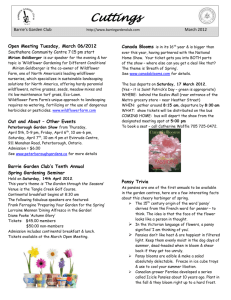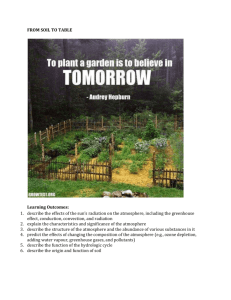Apple Seeds Starts Lesson Plan
advertisement

Apple Seeds Grade(s): K-5 Title: Starts/Plant Needs Synopsis In planting starts for their garden, students will learn that plants need adequate space, light, air, nutrients, and water to survive. Students will learn where plants get those things in nature, inside, and in the garden. Additionally, students will understand that humans exhale CO2, while plants exhale O2, making for a mutually beneficial relationship. Finally, students will practice their observation skills, watching plants grow over time, before finally transplanting them in the garden. Organizational Details Preparation: 20-60 minutes Activity: 30-80 minutes Group Size: 1+ Location: indoors Common Core: K.W.3: Use a combination of drawing, dictating and writing to narrate a single event or several loosely linked events, tell about events in the order they occurred, and provide a reaction to what happened. K.W.8: With guidance and support from adults, recall information from experience or gather information from provided sources to answer a question. K. SL.6: Speak audibly and express thoughts, feelings, and ideas clearly. 1.W.3: Write narratives in which they recount two or more appropriately sequenced events, include some detail regarding what happened, use temporal words to signal event order, and provide some sense of closure. 2.W.7: Participate in shared research and writing projects. 3. SL.4: Report on a topic or text, tell a story, or recount an experience with appropriate facts and relevant, descriptive details, speaking clearly at an understandable pace. 3/4/5.SL.1: Engage effectively in a range of collaborative discussions (one-one-one, in groups, and teacher-led) with diverse partners on grade 3 topics and texts, building on others’ ideas and expressing their own clearly. Extension—Each time you observe the plants, chart growth. How many new leaves? How tall? K.CC.4: Understand the relationship between numbers and quantities, connect counting to cardinality. K.OA.1: represent addition and subtraction with objects, fingers, mental images, drawings, sounds, acting out situations, verbal explanations, expressions, or equations. K.MD.1: Describe measurable attributes of objects, such as length or weight. Describe several measurable attributes of a single object. K.MD.2: Directly compare two objects with a measurable attribute in common, to see which object has “more of, less of” the attribute, and describe the difference. 2.MD.1: Measure the length of an object by selecting and using appropriate tools such as rulers, yardsticks, meter sticks, and measuring tapes. 2.MD.2: Measure the length of an object twice, using length units of different lengths for the two measurements; describe how two measurements relate to the size of the unit chosen. Standards Lesson Objective: Know and Think Next Generation Science: K-LS1-1: Use observations to describe patterns of what plants and animals (including humans) need to survive. 4-LS1-1: Construct an argument that plans and animals have internal and external structures that function to support survival, growth, behavior, and reproduction. 5-PS3-1: Use models to describe that energy in animal’s food was once energy from the sun. Extension—Have students design an experiment to test plant needs. 2-LS2-1: Plan and conduct an investigation to determine if plants need sunlight and water to grow. 5-LS1-1: Support an argument that plants get the materials they need for growth chiefly from air and water. Extension—compare plant life cycle with that of other organisms. 3-LS1-1: Develop models to describe that organisms have unique and diverse life cycles but all have in common birth, growth, reproduction, and death. Students will practice their skills of observation, as well as written and oral communication. Students will learn that plants require the following to live: o Place: Plants need space. o Light: Plants require light to produce food (photosynthesis). o Air: Plants use CO2 to produce food, and give off O 2 (Photosynthesis) o Nutrients: A mix of ‘food’ that plants produce on their own, and nutrients taken out of the soil. o Thirsty: Water. Students will come to understand that, although a plant’s needs can be met outside, some mature faster and more successfully when started indoors. Students may be encouraged to consider what modifications humans make to their environment in order to increase the success of the species (defined biologically). Pre-requisite Skills and Knowledge Teacher Background Info 2.MD.3: Estimate lengths using units of inches, feet, centimeters, meters. 2.MD.4: Measure to determine how much longer one object is than another expressing the length difference in terms of a standard length unit. 2.MD.10: Draw a picture graph and a bar graph to represent a data set with up to four categories. Solve simple put-together, take-apart, and compare problems using information presented in a bar graph. 5.MD.1: Convert among different-sized standard measurement units within a given measurement system, and use these conversions in solving multi-step, real world problems. Students should be familiar with basic plant parts and function, and understand that plants grow from seeds. Students should also be familiar with their school garden, and basic gardening practices. How to start seeds: Cell pack: Seed tray: 1. Fill pots/cell packs with potting soil, and place them on a tray. Do not compact the soil! 2. Gently knock the tray against a hard surface to settle the soil in each cell. Fill any remaining space with soil. 3. Soak in a thin layer of water for ~20 minutes, allowing the soil to absorb water from the bottom up. This step may be skipped if time is a limited resource. 4. Using your index and middle fingers, gently poke two holes in each cell. Space the holes ~.5 inches apart, and .25 inches deep. If you are working with large seeds, plant 1/cell. 5. Place one seed in each depression. 6. Cover fully with a thin layer of soil. 7. Mist each cell. 8. Monitor closely—your seedlings must remain moist continuously. Mist regularly to keep your plants healthy! For K-2, use larger seeds. We recommend squash, kale, or chard. Avoid starting root vegetables indoors, as they do better planted directly in the ground. In general, plant seeds twice as deep as the seed is wide. Research which plants start well indoors, and be sure to record when each plant should be transplanted. If this is your first time starting seeds, stick to one or two varieties. Chard, lettuce, and basil are good choices! Photosynthesis: Using sunlight, water and CO2, plants produce their own food (glucose). 6CO2 + 6H2O ------> C6H12O6 + 6O2 Sunlight energy Where: CO2 = carbon dioxide H2O = water Light energy is required C6H12O6 = glucose O2 = oxygen Materials Preparation Trays Pots/cell packs Potting Soil Misters Seeds Lab note books (20-60 minutes) K-2 Prep cell packs and trays for students. Fill cells/pots and soak in advance of the lesson. Research preferred varieties. Ensure that they transplant well, and that the seeds are large enough to be handled by young students with ease. 3-5 Opening Agenda Collaborative Opportunities Closing Resources Pull materials together. If you have the time, encourage students to research which varieties transplant well. (10 minutes) K-5: What do plants need to live? Where do they get those things in nature? In our gardens? How can we make sure plants get what they need in our classroom? Why do people cultivate plants? What do people use plants for? What happened to the plant before it got to your kitchen? If you wanted to grow plants at home, what would you need to do? (30-60 minutes) K-2 Have students plant seeds in the prepared trays. Discuss observation. Tell students that they will be recording their observations as the seeds grow, starting today, and finishing either when the plants are transplanted to the garden, or harvested. Students should discuss their observations in pairs, and draw a picture of their plant in their scientific notebooks. If age appropriate, have students take notes. As a class, map out when each plant will likely need to be transplanted, and when it will be ready to harvest. If students hold multiple opinions, have a competition—whose transplant/harvest date prediction was the closest? Revisit regularly, and make ongoing observations. Were students’ expectations met? After transplanting/harvesting, have students write/dictate a narrative drawing from their observations. 3-5: Have students participate in the entire seed starting process. Discuss observation. Tell students that they will be recording their observations as the seeds grow, starting today, and finishing either when the plants are transplanted to the garden, or harvested. Students should discuss their observations in pairs, recording what they notice, and including a picture. Have students use what they know of the plant life cycle to make predictions. When will their plants show the first leaves? When will they need to be transplanted? When will they be ready to harvest? Encourage students to research their plant prior to making predictions. Revisit regularly, and make ongoing observations. Were students’ expectations met? After transplanting/harvesting, have students discuss and then write a narrative drawing from their observations. Students will work together to plant seeds and make observations. (10-20 minutes) Remind students that we will have to care for our starts. Ask again what we will have to do regularly to ensure survival. We will transplant successful seedlings in our school garden! Have students share their observations and predictions. http://www.motherearthnews.com/homesteading-andlivestock/starting-seeds-indoors.aspx http://www.marthastewart.com/268497/seed-starting-with-kids http://www.kidsgardening.org/node/96821 http://www.fantasticfunandlearning.com/starting-seeds-with-kids.html Plant reference guide(s) o Rodale’s Garden Answers: Vegetables, Fruits and Herbs. Ed. Bradley, Fern Marshall. o Grow Your Own Vegetables (Klein, Carol)






